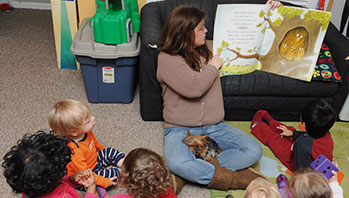- vegetables featured in the book (tomatoes, chilies, onions)
- plant
- sombrero
MA Standards:
Literature/RL.PK.MA.1: With prompting and support, ask and answer questions about a story or a poem read aloud.
Literature/RL.PK.MA.4: With prompting and support, ask and answer questions about unfamiliar words in a story or poem read aloud.
RL.PK.MA.10: Listen actively as an individual and as a member of a group to a variety of age-appropriate literature read aloud.
Head Start Outcomes:
Literacy Knowledge/Book Appreciation and Knowledge: Asks and answers questions and makes comments about print materials.
PreK Learning Guidelines:
English Language Arts/Reading and Literature 6: Listen to a wide variety of age appropriate literature read aloud.
English Language Arts/Reading and Literature 10: Engage actively in read-aloud activities by asking questions, offering ideas, predicting or retelling important parts of a story or informational book.
Read Together: Chicks and Salsa #2

© Commonwealth of Massachusetts, Department of Early Education and Care (Jennifer Waddell photographer). All rights reserved.
STEM Key Concepts: Plants grow in many places; Many foods that animals, including humans, eat come from plants; We eat certain leaves, roots, fruits, and seeds
ELA Focus Skills: Appreciating Diversity, Concepts of Print, Listening and Speaking, Story Comprehension (Plot), Vocabulary
Before You Read
Hold up the book for children to see. Ask, Who is on the cover of the book? Ask children to recall what they remember about the rooster. Point to the hat the rooster is wearing and ask children to describe the hat. Tell them the hat is called a sombrero. Explain that sombrero is the Spanish word for a hat with a big, wide brim.
Tell children that there might be foods mentioned in the book that they may not know. Explain that people all over the world eat different foods. Say, Sometimes a plant grown in a different part of the world may not grow here. So, it might not be something we have not seen or tasted before. Set a focus for children by having them listen for all the plants that the animals find and use in their recipes and to think about whether they have ever seen or eaten those plants before.
As You Read
Chicks and Salsa is full of wonderful words.
- As you read, point to illustrations to clarify the meaning of unfamiliar words and phrases.
- Pause after “. . . they took tomatoes and uprooted onions.” Ask, What do you think it means to “uproot” something?
- Pause after “Spicy scent of garlic and cilantro hung over the barnyard.” Ask children if they know what the word scent means. If they do not know the word, explain that it is the smell of the food. Then ask, What do you think it means that the “scent hung over the barnyard”?
- Pause to clarify unfamiliar words such as slop, savory, aroma, and cilantro.
- Encourage children to call out “Olé” and “Ooh, la, la” with the animals.
After You Read
Talk with children about the book.
- Ask children if they have ever had any of the foods in the book. Encourage them to share when they have had these foods with their families. Prompt them to tell if it is a special dish, for a special occasion, etc.
- Help children to use some of the descriptive vocabulary words in the book to describe a favorite food of theirs. For example, “I like the <spicy taste> of pepperoni pizza.” “I like the <aroma> of popcorn.”
Cultural Connection: This book offers an opportunity to engage children to share any ethnic foods they eat at home. Invite children to talk about which foods they are served at home. Encourage them to name the ingredients in favorite dishes and what they know about how they are prepared.
